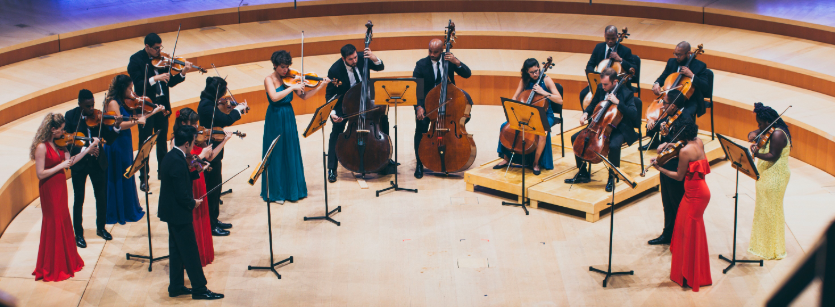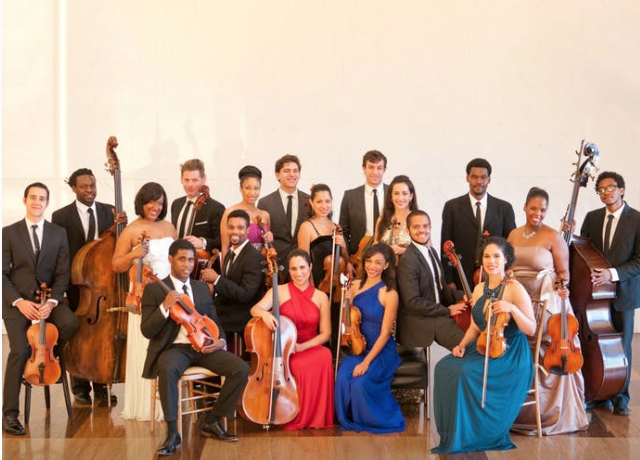Sphinx Virtuosi; J’Nai Bridges, mezzo-Ssoprano; Will Liverman, baritone; Damien Sneed, piano; Chorale Le Chateau
Stern Auditorium at Carnegie Hall, New York, NY
October 11, 2019
A packed Carnegie Hall greeted the Sphinx Virtuosi for their annual New York concert on October 11. The program, entitled “For Justice and Peace,” consisted of seven pieces, all of which were in some way related to injustice, protest, and the hope for a better future. The eighteen -member ensemble more than lived up to its name: the performance of every composition was on the highest level.
The Sphinx Organization is one of the brightest lights in the cultural firmament of this country. It was founded twenty-two years ago by Aaron P. Dworkin, who at the time was an undergraduate at the University of Michigan. He was distressed by the underrepresentation of people of color in classical music and decided to do something about it. His success has been phenomenal. The programs under the umbrella of the Sphinx Organization span education initiatives, annual competitions and scholarships, professional performance opportunities, and leadership training and career development. From the beginning violin students in Detroit and Flint elementary schools to the extraordinary recipients of the $50,000 Sphinx Medals of Excellence, Sphinx has empowered musicians of color to succeed onstage and off.
Friday’s program started off with Fuga con Pajarillo, by the twentieth-century Venezuelan composer Aldemaro Romero. The beginning sounded like Bach, but after a while the Latin rhythm of the pajarillo, a Venezuelan dance form, appeared. After the performance, the concertmaster (and excellent soloist) for this piece, told us that it was programmed to celebrate the great musical tradition in Venezuela, his native country, which is presently going through very difficult times. It was performed with expertise and aplomb, getting the program off to a fine start.
Next we heard the final movement Allegro assai from Bartók’s Divertimento for Strings of 1939. As the program explained, Bartók was an immigrant, fleeing Europe after the rise of Hitler, and hoping to find justice and peace in this country. He wrote this piece shortly before his departure from Hungary.
After a fine display of virtuosity in the first two selections, there was a calming respite in Philip Herbert’s Elegy: In Memoriam – Stephen Lawrence. Mr. Lawrence was a British man who was killed in a racial incident. This beautiful work employed harmonic and melodic material from both Barber’s Adagio for Strings and Ravel’s Pavane for a Dead Princess. And why not? Homage is a respected technique in musical composition, and has been employed by the greatest composers. This Elegy was beautiful in its own right, and no doubt drew a tear from more than one eye.
I was intrigued by the title of the next piece, Global Warming. Climate change is certainly a hot topic today, but how could one compose a piece about it? The answer came from the woman who introduced it- each composition, after Fuga con Pajarillo, received an introduction from the stage by one of the performers. Composed shortly after the fall of the Berlin wall, it refers not to climate change but to the “celebration of divergent cultures through their own folk music.” Written with a warm sense of hopefulness about the planet and global relations, it was one of the first works by an African- American composer to be performed by the National Symphony of South Africa after the election of Nelson Mandela. Irish fiddling encountered Middle Eastern modality to their mutual benefit. For this listener, though, it went on a little too long.
The next piece, from which the concert took its title, was For Justice and Peace, for Violin, Bass, and String Orchestra by the Sphinx Virtuosi’s composer-in-residence and bass player, Xavier Foley. Co-commissioned by the New World Symphony, Sphinx Organization and Carnegie Hall, tonight’s performance marked its New York premiere. Mr. Foley wrote ,“I felt it was my job to illustrate how the issues of justice and peace remain critical to our society today.” On this occasion, the Sphinx was joined by the excellent Venezuelan violinist Rubén Rengel, 22, winner of the 2018 Annual Sphinx Competition. Mr. Rengel and Mr. Foley, on bass, showed off their great virtuosity on difficult solo lines. The sound of a gavel, struck by one of the violinists, and quotations from spirituals added to a portrayal of the justice system and, in Mr. Foley’s words, “certain challenges it faces.” This deeply affecting work earned a standing ovation.
What could follow this heartfelt tribute? Very fast Schubert, of course! Shortly before composing the Death and the Maiden Quartet, it turns out, Schubert, along with some rowdy friends, was arrested by the Austrian secret police for “insulting and opprobrious language.” According to the program notes, having this blot on his name was a hindrance to his activities. Hence Herr Schubert’s anti-oppression bona fides. The final movement, Presto, from the aforementioned quartet was performed with urgent intensity.
The last piece on the program was Our Journey: 400 Years from Africa to Jamestown. This was the first performance of the opening of the opera We Shall Overcome by Damien Sneed. Two excellent young singers, mezzo-soprano J’Nai Bridges, and baritone Will Liverman, the small but sonorous Chorale Le Chateau, and Mr. Sneed on piano joined the Sphinx for a moving description of the arduous Atlantic crossing, the opening of Mr. Sneed’s opera. This four-minute excerpt made me want to hear more of this work, which combines African rhythms, spirituals, gospel, jazz, and European musical techniques.
Indeed my only slight reservation about this concert was the short length of all its works. Besides the Sneed excerpt, the Schubert offering was one movement from a quartet, and the Bartók was a movement of a divertimento. The average length of a piece was less than eight minutes. As a frequent concertgoer, I am used to hearing at least one work of a substantial length from a Carnegie Hall concert. Even vocal recitals organize single songs into sets. There were other unusual aspects to the program as well. There was no intermission, and midway through the concert a screen was lit and a short film about the Sphinx Organization was shown. Afterwards, the President and Artistic Director, Afa S. Dworkin gave a speech. Then we returned to the music.
Any reservations of mine about the unusual format of this concert were not shared by the audience. The evening ended with a long and ecstatic ovation.


